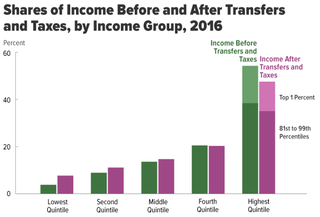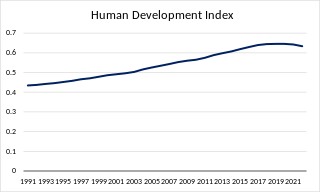
In economics, the Gini coefficient, also known as the Gini index or Gini ratio, is a measure of statistical dispersion intended to represent the income inequality, the wealth inequality, or the consumption inequality within a nation or a social group. It was developed by Italian statistician and sociologist Corrado Gini.

Economic inequality is an umbrella term for a) income inequality or distribution of income, b) wealth inequality or distribution of wealth, and c) consumption inequality. Each of these can be measured between two or more nations, within a single nation, or between and within sub-populations.

Social mobility is the movement of individuals, families, households or other categories of people within or between social strata in a society. It is a change in social status relative to one's current social location within a given society. This movement occurs between layers or tiers in an open system of social stratification. Open stratification systems are those in which at least some value is given to achieved status characteristics in a society. The movement can be in a downward or upward direction. Markers for social mobility such as education and class, are used to predict, discuss and learn more about an individual or a group's mobility in society.

In economics, income distribution covers how a country's total GDP is distributed amongst its population. Economic theory and economic policy have long seen income and its distribution as a central concern. Unequal distribution of income causes economic inequality which is a concern in almost all countries around the world.
Income inequality metrics or income distribution metrics are used by social scientists to measure the distribution of income and economic inequality among the participants in a particular economy, such as that of a specific country or of the world in general. While different theories may try to explain how income inequality comes about, income inequality metrics simply provide a system of measurement used to determine the dispersion of incomes. The concept of inequality is distinct from poverty and fairness.

Economic mobility is the ability of an individual, family or some other group to improve their economic status—usually measured in income. Economic mobility is often measured by movement between income quintiles. Economic mobility may be considered a type of social mobility, which is often measured in change in income.
In economics, personal income refers to the total earnings of an individual from various sources such as wages, investment ventures, and other sources of income. It encompasses all the products and money received by an individual.

Income inequality has fluctuated considerably in the United States since measurements began around 1915, moving in an arc between peaks in the 1920s and 2000s, with a 30-year period of relatively lower inequality between 1950 and 1980.
Income in India discusses the financial state in India. With rising economic growth and prosperity, India's income is also rising rapidly. As an overview, India's per capita net national income or NNI was around Rs. 98,374 in 2022-23. The per-capita income is a crude indicator of the prosperity of a country. In contrast, the gross national income at constant prices stood at over 128 trillion rupees. According to a 2021 report by the Pew Research Center, India has roughly 1.2 billion lower-income individuals, 66 million middle-income individuals, 16 million upper-middle-income individuals, and barely 2 million in the high-income group. According to The Economist, 78 million of India's population are considered middle class as of 2017, if defined using the cutoff of those making more than $10 per day, a standard used by the India's National Council of Applied Economic Research. According to the World Bank, 93% of India's population lived on less than $10 per day, and 99% lived on less than $20 per day in 2021.

Social inequality occurs when resources within a society are distributed unevenly, often as a result of inequitable allocation practices that create distinct unequal patterns based on socially defined categories of people. Differences in accessing social goods within society are influenced by factors like power, religion, kinship, prestige, race, ethnicity, gender, age, sexual orientation, intelligence and class. Social inequality usually implies the lack of equality of outcome, but may alternatively be conceptualized as a lack of equality in access to opportunity.
Income inequality in the Philippines is the extent to which income, most commonly measured by household or individual, is distributed in an uneven manner in the Philippines.
China's current mainly market economy features a high degree of income inequality. According to the Asian Development Bank Institute, “before China implemented reform and opening-up policies in 1978, its income distribution pattern was characterized as egalitarian in all aspects.”
Brazil has high income inequality despite high rates of economic growth. The country's richest 1% of the population have 13% of all household income, a similar economic result to that of the poorest 50%. This inequality results in poverty levels that are inconsistent with an economy the size of that of Brazil. The country's GDP growth in 2010 was 7.5%. In recent decades, there has been a modest decline in inequality for the country as a whole. Brazil's GINI coefficient, a measure of income inequality, has slowly decreased from 0.596 in 2001 to 0.543 in 2009. However, the numbers still point to a rather significant problem of income disparity.

Income inequality in India refers to the unequal distribution of wealth and income among its citizens. According to the CIA World Factbook, the Gini coefficient of India, which is a measure of income distribution inequality, was 35.2 in 2011, ranking 95th out of 157. Wealth distribution is also uneven, with one report estimating that 54% of the country's wealth is controlled by millionaires, the second highest after Russia, as of November 2016. The richest 1% of Indians own 58% of wealth, while the richest 10% of Indians own 80% of the wealth. This trend has consistently increased, meaning the rich are getting richer much faster than the poor, widening the income gap. Inequality worsened since the establishment of income tax in 1922, overtaking the British Raj's record of the share of the top 1% in national income, which was 20.7% in 1939–40.

Socioeconomic mobility in the United States refers to the upward or downward movement of Americans from one social class or economic level to another, through job changes, inheritance, marriage, connections, tax changes, innovation, illegal activities, hard work, lobbying, luck, health changes or other factors.

The "Great Gatsby Curve" is the term given to the positive empirical relationship between cross-sectional income inequality and persistence of income across generations. The scatter plot shows a correlation between income inequality in a country and intergenerational income mobility.

Effects of income inequality, researchers have found, include higher rates of health and social problems, and lower rates of social goods, a lower population-wide satisfaction and happiness and even a lower level of economic growth when human capital is neglected for high-end consumption. For the top 21 industrialised countries, counting each person equally, life expectancy is lower in more unequal countries. A similar relationship exists among US states.
Education inequality in China exists on multiple levels, with significant disparities occurring along gender, geographical, and ethnic divides. More specifically, disparities exist in the distribution of educational resources nationwide, as well as the availability of education on levels, ranging from basic to higher education.
The spoon class theory refers to the idea that individuals in a country can be classified into different socioeconomic classes based on the assets and income level of their parents, and as a consequence, one's success in life depends entirely on being born into a wealthy family. The term appeared in 2015 and was first widely used among online communities in South Korea.
According to data from 2010, low-income earners make up 37.8% of South Korea's labour force. Conversely, the highest income earners make up 1.4% of the labour force.











